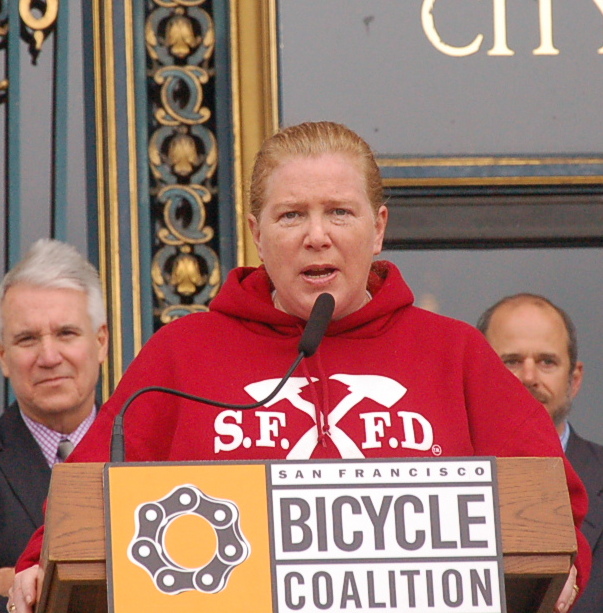The SF Fire Department's top brass, who have recently blamed safer street designs for slowing emergency response times, are coming under fire as evidence mounts that SFFD's own management problems may be to blame. The department lacks sufficient medical staff, equipment, and emergency vehicles, according to a report released in June, and officials apparently neglected to purchase new vehicles with public funds intended for that purpose.

Today, SFFD's rank-and-file firefighter organizations penned a letter calling on Mayor Ed Lee to replace Fire Chief Joanne Hayes-White to address "the crisis in public safety," the SF Chronicle reported. Last week, the Chronicle reported that Supervisor London Breed, a former fire commissioner, "has lost confidence in the leadership of the San Francisco Fire Department":
The Fire Department has increasingly struggled to get ambulances to medical emergencies to transport patients to the hospital, an issue that has been detailed in several city reports this year. While fire trucks with at least one paramedic on board respond to all 911 calls within minutes to administer medical care, patients are regularly waiting for long periods for an ambulance to arrive - it happened 2,500 times in 2013, a fourfold increase since 2008 and 25 percent jump over 2012.
In August, according to data presented to the Fire Commission last month, there were more than 374 incidents where it took more than 20 minutes for an ambulance to arrive at a call - including nine cases where it took more than an hour...
The problem is driven by a lack of proper staffing and equipment, according to a June report by the Board of Supervisors' budget and legislative analyst that determined the department needs 16 more medics and that more than half of its ambulance fleet is ready to be retired.
The report found that the Fire Department has been given enough money to buy 16 ambulances since 2012, but "not even one of these 16 ambulances has been purchased to date." Hayes-White and other department officials said at the time that they expect to have the ambulances by year's end.
Rather than focus on addressing these shortages, SFFD officials have recently blamed slower response times on street safety measures like pedestrian bulb-outs and traffic lane reductions, which are proven to reduce the very crashes and injuries SFFD responds to.
In January, Assistant Deputy Chief Ken Lombardi told the SF Pedestrian Safety Advisory Committee that response times for stations in the Mission and the Castro areas have increased an average of 19 seconds in the past four years, compared to 10 seconds citywide. However, he admitted, “I don’t know if it’s a traffic calming measure or not, there might just be more cars there.” Fire Marshall Michie Wong said at the hearing that the department doesn’t have a way to determine what’s causing response delays.
Lombardi didn't specify in his presentation whether the response times he cited included ambulances in addition to fire trucks, and SFFD hasn't responded to Streetsblog's request to clarify its use of data. However, 73 percent of SFFD's calls are for medical emergencies, and the department clearly includes ambulance calls when citing response times. Following another Chronicle article about "delays compound[ing] SF's ambulance crisis," for instance, SFFD said that response times have improved by an average of one and a half minutes within the last two weeks, after the department hired 35 new medical staffers.
The fact that SFFD is touting that cause-and-effect relationship only bolsters the case that shortages are the primary source of its worsening response times. “We knew that there would be some immediate relief," Hayes-White said in a statement.
Yet SFFD has cited response time concerns to impose wider streets in city planning projects. In one egregious instance, SFFD stepped in at the 11th hour to undermine the planned street widths in the new Candlestick Point development, but later signed off on most of the original plans after Supervisor Scott Wiener and other city officials held their ground. At the time, Wong said SFFD was "imposing the authority to use whatever we need to justify the increased width," and that using the suburban-oriented International Fire Code standard “as a guideline is sound judgment.”
Last December, Hayes-White also claimed that pedestrians are at fault for their own injuries in up to "74 percent" of cases, but later said she'd "misinterpreted" the data.





